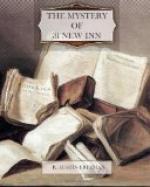“’I went out and met a policeman just by Dane’s Inn and told him about the affair, and he came back with me. He and the porter consulted together, and then they told me to go up the ladder and get in at the window and open the door of the chambers from the inside. So I went up; and as soon as I got in at the window I saw that the gentleman was dead. I went through the other room and opened the outer door and let in the porter and the policeman.’
“That,” said Mr. Marchmont, laying down the paper containing the depositions, “is the way in which poor Jeffrey Blackmore’s death came to be discovered.
“The constable reported to his inspector and the inspector sent for the divisional surgeon, whom he accompanied to New Inn. I need not go into the evidence given by the police officers, as the surgeon saw all that they saw and his statement covers everything that is known about Jeffrey’s death. This is what he says, after describing how he was sent for and arrived at the Inn:
“’In the bedroom I found the body of a man between fifty and sixty years of age, which has since been identified in my presence as that of Mr. Jeffrey Blackmore. It was fully dressed and wore boots on which was a moderate amount of dry mud. It was lying on its back on the bed, which did not appear to have been slept in, and showed no sign of any struggle or disturbance. The right hand loosely grasped a hypodermic syringe containing a few drops of clear liquid which I have since analysed and found to be a concentrated solution of strophanthin.
“’On the bed, close to the left side of the body, was a brass opium-pipe of a pattern which I believe is made in China. The bowl of the pipe contained a small quantity of charcoal, and a fragment of opium together with some ash, and there was on the bed a little ash which appeared to have dropped from the bowl when the pipe fell or was laid down. On the mantelshelf in the bedroom I found a small glass-stoppered jar containing about an ounce of solid opium, and another, larger jar containing wood charcoal broken up into small fragments. Also a bowl containing a quantity of ash with fragments of half-burned charcoal and a few minute particles of charred opium. By the side of the bowl were a knife, a kind of awl or pricker and a very small pair of tongs, which I believe to have been used for carrying a piece of lighted charcoal to the pipe.
“’On the dressing-table were two glass tubes labelled “Hypodermic Tabloids: Strophanthin 1/500 grain,” and a minute glass mortar and pestle, of which the former contained a few crystals which have since been analysed by me and found to be strophanthin.
“’On examining the body, I found that it had been dead about twelve hours. There were no marks of violence or any abnormal condition excepting a single puncture in the right thigh, apparently made by the needle of the hypodermic syringe. The puncture was deep and vertical in direction as if the needle had been driven in through the clothing.




